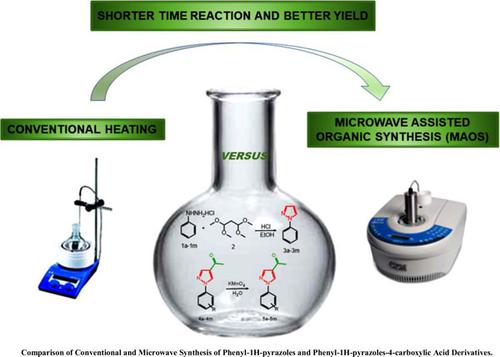Current Organic Synthesis ( IF 1.7 ) Pub Date : 2021-11-30 , DOI: 10.2174/1570179418666210618162518 Antônio S Machado 1 , Flávio S de Carvalho 1 , Rayssa B P Mouraa 1 , Lorrayne S Chaves 1 , Luciano M Lião 2 , Germãn Sanz 3 , Boniek G Vaz 3 , Marcella F Rodrigues 3 , Wanderson Romão 4 , Ricardo Menegatti 1 , Gloria N S Silva 1

|
Background: Privileged scaffolds are of high importance for molecules containing the pyrazole subunit due to their broad spectrum of pharmacological activities. For this reason, a method that is more efficient needs to be developed for the preparation of pyrazole derivatives.
Objective: The purpose of this study was the optimisation of the conventional synthesis of the pyrazole ring and the oxidation of phenyl-1H-pyrazole-4-carbaldehyde to phenyl-1H-pyrazole-4-carboxylic acid through Microwave- Assisted Organic Synthesis (MAOS).
Methods: We performed a comparison between conventional synthesis and conventional synthesis with microwave heating using the synthesis method of pyrazole ring described by Finar and Godfrey and for the oxidation of phenyl-1H-pyrazole-4-carbaldehyde, the method described by Shriner and Kleiderer was used.
Results: MAOS reduces the reaction time to obtain all compounds compared to conventional heating. At a temperature of 60°C, 5 minutes of reaction time, and power of 50 W, the yield of phenyl-1H-pyrazoles (3a-m) compounds was in the range of 91 - 98% using MAOS, which is better than conventional heating (72 - 90%, 75ºC, 2 hours). An improvement in the yield for the oxidation reaction was also achieved with MAOS. The compounds (5a-m) were obtained with yields ranging from 62 - 92% (80ºC, 2 minutes, 150 W), while the yields with conventional heating were in the range of 48 - 85% (80ºC, 1 hour). The 26 compounds were achieved through an easy work-up procedure with no chromatographic separation. The pure products were characterised by the spectral data obtained from IR, MS, 1H and 13C NMR or HSQC/HMBC techniques.
Conclusion: The advantages of MAOS include short reaction time and increased yield, due to which it is an attractive option for pyrazole compounds synthesis.
中文翻译:

苯基-1H-吡唑和苯基-1H-吡唑-4-羧酸衍生物的常规合成和微波合成比较
背景:特权支架因其广泛的药理活性而对含有吡唑亚基的分子非常重要。出于这个原因,需要开发一种更有效的方法来制备吡唑衍生物。
目的:本研究的目的是优化吡唑环的常规合成以及通过微波辅助有机合成(MAOS)将苯基-1H-吡唑-4-甲醛氧化为苯基-1H-吡唑-4-羧酸。 )。
方法:我们使用 Finar 和 Godfrey 描述的吡唑环的合成方法对常规合成和微波加热的常规合成进行了比较,对于 phenyl-1H-pyrazole-4-carbaldehyde 的氧化,Shriner 和 Kleiderer 描述的方法是用过的。
结果:与传统加热相比,MAOS 缩短了获得所有化合物的反应时间。在 60°C 的温度、5 分钟的反应时间和 50 W 的功率下,使用 MAOS 的苯基-1H-吡唑 (3a-m) 化合物的收率在 91 - 98% 范围内,优于常规加热(72 - 90%,75ºC,2 小时)。MAOS还实现了氧化反应产率的提高。化合物 (5a-m) 的产率范围为 62 - 92%(80ºC,2 分钟,150 W),而常规加热的产率范围为 48 - 85%(80ºC,1 小时)。26 种化合物是通过简单的后处理程序获得的,无需色谱分离。纯产物通过从 IR、MS、1 H 和13获得的光谱数据进行表征C NMR 或 HSQC/HMBC 技术。
结论:MAOS 的优点包括反应时间短和产率提高,因此它是吡唑类化合物合成的一个有吸引力的选择。


















































 京公网安备 11010802027423号
京公网安备 11010802027423号